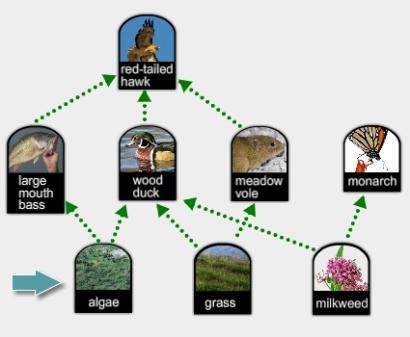80 points
who are the consumers of the organism represented by the blue arrow?
the lar...

Biology, 23.08.2019 17:30 terrickaimani
80 points
who are the consumers of the organism represented by the blue arrow?
the large-mouth bass and the wood duck
the large-mouth bass and the red-tailed hawk
the wood duck and the red-tailed hawk
the wood duck and the meadow vole
for the next question pointing at the red tailed hawk
which statement describes the role of the organism indicated by the blue arrow in the food web?
a primary producer that recycles organic molecules from sunlight
a secondary consumer that obtains its energy from the consumption of animals
a primary consumer that obtains its energy from the consumption of animals
a secondary consumer that recycles organic molecules by breaking them down
what would happen in an ecosystem without primary consumers?
the populations of producers would increase.
the populations of decomposers would decrease.
the populations of omnivores would increase.
the populations of carnivores would increase.


Answers: 2
Another question on Biology

Biology, 21.06.2019 18:00
Ecosystems involve living organisms interacting with non-living things in a productive way; how is photosynthesis an example of this? answer, i will give brainiest to first person to get it right.
Answers: 1


Biology, 22.06.2019 01:30
Scenario 5 1) take 10 red and 10 black beans and place them, mixed, on the table. record the starting phenotype # and frequencies (% of your total population) of your starting population in the table provided (generation 0). 2) act as a predator. “capture” as many organisms as you can until you have reduced the population to three organisms. put them aside. at this point, the predators die. 3) the remaining organisms each produce 2 clonal offspring. multiply your organisms accordingly and allow them to mix on the table. calculate and record the resultant phenotype # and frequencies (% of your total population) of your population in the table provided (generation 1). 4) repeat the reproduction event, allowing each of your organisms to produce 2 clonal offspring. calculate and record the resultant phenotype # and frequencies (% of your total population) of your population in the table provided (generation 2). 5) repeat the reproduction event, allowing each of your organisms to produce 2 clonal offspring. calculate and record the resultant phenotype # and frequencies (% of your total population) of your population in the table provided (generation 3).
Answers: 1

Biology, 22.06.2019 02:30
In the diagram below, the northern hemisphere would be in what season at position a a.fall b. winter c.summer d.spring
Answers: 1
You know the right answer?
Questions

Arts, 13.05.2021 20:00


Mathematics, 13.05.2021 20:00


English, 13.05.2021 20:00


History, 13.05.2021 20:00





Mathematics, 13.05.2021 20:00

Mathematics, 13.05.2021 20:00

Mathematics, 13.05.2021 20:00





English, 13.05.2021 20:00



